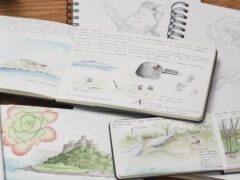Snow Goose Photo Gallery
Adult white morph
All white plumage with black wingtips visible at rest. The pink bill shows a curved base and a prominent black grin patch.
© Brad Imhoff / Macaulay LibraryOhio, December 23, 2020Adult blue morph
Blue morph is the same shape and size as the white morph, with a variably dark body and a white head. Note the curved bill base and the black grin patch on the pink bill.
© Charles Hundertmark / Macaulay LibraryColorado, February 08, 2017Adult white morph
Forages in wide-open spaces, such as cultivated fields and shallow wetlands during the nonbreeding season.
© Jay McGowan / Macaulay LibraryNew York, March 19, 2015Not all videos have soundAdult intermediate morph
Dark-plumaged birds are quite variable and may show a white belly contrasting with dark body plumage. The orange color on the head is from iron oxides that stain white plumage while foraging.
© Simon Boivin / Macaulay LibraryQuebec, May 07, 2017Adult white morph
In flight, all white with black primaries. Distinguishing Snow and Ross's geese in flight is difficult but can be attempted with direct comparisons or good views of the head and bill structure—longer in Snow, more compact in Ross's.
© Darren Clark / Macaulay LibraryIdaho, March 17, 2018Adult white morph
Snow Geese typically give numerous nasal honks in flight. Their black wingtips are highly visible in flight even at a distance.
© Tom Johnson / Macaulay LibraryArizona, January 01, 2014Not all videos have soundJuvenile white morph
White with dusky gray-brown on head, neck, and wings. Bill and legs are dusky pink. The large black grin patch on the bill is a useful character.
© Levi Plummer / Macaulay LibraryArizona, December 31, 2018Juvenile blue morph
Entirely dark sooty gray at rest; long bill structure with an arched grin patch is identical to the pattern shown by paler Snow Geese.
© Suzanne Labbé / Macaulay LibraryQuebec, November 14, 2016Flock (white and blue morphs)
Snow Geese often form massive flocks during the nonbreeding season, and often make mass exoduses.
© Brian Sullivan / Macaulay LibraryMissouri, February 29, 2012Not all videos have soundAdult blue morph and adult white morph
White and blue morphs commonly flock together, but white almost always outnumber blue. Note the white armpits of the blue morph adult here—this contrast helps to distinguish this color variant from other species of dark geese which have dark underwings.
© Martina Nordstrand / Macaulay LibraryNew Mexico, January 02, 2018Adult blue morph (with Canada Goose)
Shorter-necked and more compact at rest than Canada Goose. This dark morph adult shows a mostly dark body with white head and a large pale upperwing patch.
© Fred Jennings / Macaulay LibraryOntario, October 01, 2016Flock (white and blue morphs)
This flock in the Midwest contains both white and blue morph individuals. Blue morphs tend to be more common in the Midwest and along the Gulf Coast.
© Timothy Barksdale / Macaulay LibraryMissouri, December 01, 1998Not all videos have soundAdult white morph and adult blue morph
Often forages in large flocks during migration and winter. White and blue morphs flock together and interbreed freely, though white morphs are more common.
© Joshua Covill / Macaulay LibraryMontana, March 29, 2017Flock
Frequently occurs in shimmering flocks of hundreds of thousands during migration and winter.
© Marky Mutchler / Macaulay LibraryMissouri, February 12, 2017Compare with Similar Species
Click on an image to compare
Species in This Family
Ducks, Geese, and Waterfowl(Order: Anseriformes, Family: Anatidae)
More to Read
Don't miss a thing! Join our email list
The Cornell Lab will send you updates about birds,
birding, and opportunities to help bird conservation.




























































